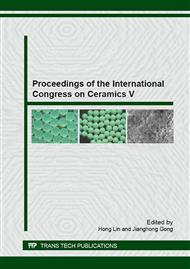p.212
p.216
p.220
p.224
p.230
p.234
p.240
p.244
p.249
Effects of Ni Sheath on the Microstructure and Properties of BSCCO-2223 Tapes
Abstract:
Effects of Ni sheath on the microstructure, mechanical properties and bubbling phenomenon during heating process of BSCCO-2223 ceramic tapes have been investigated. Ni sheath gives Bi-2223 tapes a better ability to protect ceramic core from the damage of external force. Hardness of Ni sheath is double than that of Ag sheath reached to about 70 HV. Tensile strength of the Ni-sheathed Bi-2223 tapes is also enhanced by 80%. Harder Ni sheath is also beneficial to improve the texture of the tapes. However, serious bubbling phenomenon, which can reduce the transport property of tapes, will appear during heating process owing to the bad oxygen permeability of Ni. A lower heating rate (30°C/h) is a favorite to decrease the number and size of bubbles. In addition, Ni sheath can reduce the formation rate of Bi-2223 phase which implies that longer sintering time and higher cost of fabrication will be consumed.
Info:
Periodical:
Pages:
230-233
Citation:
Online since:
July 2015
Authors:
Keywords:
Price:
Сopyright:
© 2015 Trans Tech Publications Ltd. All Rights Reserved
Share:
Citation:


